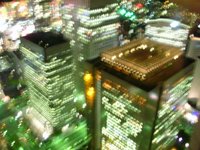Utsubo Park

This Friday I went with a friend to an exhibition of contemporary German photography at the Museum for Modern Art in Kyoto. The exhibition was called Zwischen Wirklichkeit und Bild: Positionen der Gegenwart. The exhibition is about contemporary German photography from the 1980s to today. Their are pictures byt the leading figures of German photography since the 1970s are Bernd and Hilla Becher, who photograph industrial buildings. They always take black and white pictures of those industrial constructions, like water towers, factory halls and mineshaft, in the same clinical manner: a front and profile angle provide a clear and objective documentation of each structure, the building is placed in the centre of the frame and isolated from its environment. One of the intriguing things is that they take those pictures of those structures and by putting them together all these structures kind of get a personality and one can see the differences in structure although their function stays the same. The other thing that stroke me was the total absent of humans in their pictures, although the buildings are there because of human efforts.
At the same time as I was at the art gallery, my German friends were in Osaka at Utsubo Park shooting material for a documentary we are making about the homeless living in that park. There are 30 homeless living in tents in Utsubo park. Most of the homeless are single males and in their between the 50’s. They got laid off by their companies, usually in construction work, and being unable to pay the rent they end up on the streets. Usually by doing all kinds of petty jobs, including those for the yakuza, they are able to get some money to keep themselves in live and be able to buy the material for building a tent. The estimate is that there are about 10000 homeless people in Osaka and that more than 200 of them die in one year because of starvation or because they freeze to dead. Osaka wants to evict the homeless from the Utsubo park and turn down the tents, because in May there’s going to be held the 'World Rose Convention 2006' and they are afraid that all those blue tents with homeless people in front of them is going to give them a bad image and that it might hurt tourism. The homeless received a official order from the city to leave the park, and as an alternative they are offered a place in a shelter also called "self independent centers". Which sounds as a reasonable alternative, but the trick is that they are expected to have found a job and be able to get back in society in a few months, and thus they have to leave the shelter after a month. Because a great number of the homeless has not had a regular job for almost 10 years, the actual chance of finding work is really limited. Which basically means that they are back on the street again but this time even without a tent.
It’s obvious that the homeless do not want this to happen, so the homeless of Utsubo park filed a law suit against the eviction order of their park from Osaka city. My friends and I have followed the homeless of Utsubo park with a video camera for almost a week. We filmed them at their tents, but also in their actions to call attention of both the public as well as Osaka city for their case. Today it was announced that the homeless have won their lawsuit against the city of Osaka but the question is still whether or not the park is going to be evicted on Monday the 30th.
If buildings are capable of getting personality when grouped together I also hope that the city of Osaka can see those homeless people also being distinct human individuals, who all have their own stories, and all had a live as an ordinary citizen before they were homeless.
And we think it is worth that their sides is also heard, although we know that we also blur the distinction between reality and image by making a documentary about them. But for them it is the hard reality, that they are now facing the fact that one of the most basic needs, a space for living, is going to be destroyed.


